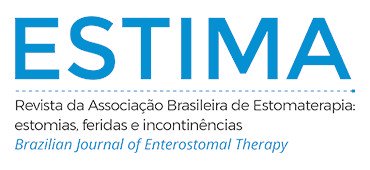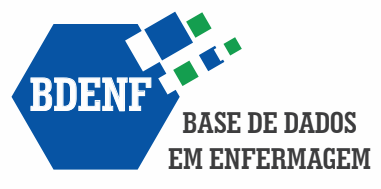CONTRIBUTIONS OF NURSES IN BASIC RESEARCH: DRESSING FIXATION MODEL FOR EXCISIONAL CUTANEOUS WOUNDS OF MICE
Abstract
Objective: validate method of fixation of dressings on excisional cutaneous wounds of mice. Method: preclinical study. Sample made up of animals of the C57BL/6 strain, which had two excision wounds made in the dorsal region. Different methods and products, widely accepted in clinical practice, for fixing dressings in the animal model were evaluated. The evaluated outcomes were the length of stay of the dressing and the occurrence of adverse events. Results: crepe bandage, microporous tape and self adhesive bandage had a shorter residence time when compared to polyurethane film. This, in turn, varied the time when comparing different marks (E, F, G and H) and number of turns around the animal’s body. With 1 lap, the time varied from <24 to 36 hours. With 2 laps, the marks E and G remained 48 and 96 hours, respectively, and F and H time <24 hours. G-brand film, cut to size 3 cm x 15 cm, giving the mouse body 2 turns, kept the dressing for 96 hours. The skin remained intact, with no adverse event. Conclusion: a dressing fixation model for wounds in mice was created with a product available in Brazil and compatible with the animal’s body structure.
Downloads
Metrics
References
Storey S, Wagnes L, LaMothe J, Pittman J, Cohee A, Newhouse R. Building evidence-based nursing practice capacity in a large statewide health system: A Multimodal Approach. J Nurs Adm. 2019;49(4):208-14. https://doi.org/10.1097/NNA.0000000000000739
Perry CJ, Lawrence AJ. Hurdles in basic science translation. Front Pharmacol. 2017;8:478. https://doi.org/10.3389/fphar.2017.00478
Rowsey PJ. Using animals in nursing research: bridging gaps between bench, bedside, and practice. West J Nurs Res. 2015;37(12): 1515-6. https://doi.org/10.1177/0193945915578815
Lodhi S, Vadnere GP. Relevance and perspectives of experimental wound models in wound healing research. Asian J Pharm Clin Res. 2017;10(7):57-62. https://doi.org/10.22159/ajpcr.2017.v10i7.18276
Cai H, Li G. Efficacy of alginate-and chitosan-based scaffolds on the healing of diabetic skin wounds in animal experimental models and cell studies: a systematic review. Wound Rep Reg. 2020; 28(6):751-71. https://doi.org/10.1111/wrr.12857
Parnell LKS, Volk SW. The Evolution of Animal Models in Wound Healing Research: 1993-2017Adv in wound care (New Rochelle). 2019; 8(12):692-702. https://doi.org/10.1089/wound.2019.1098
Hu J, Guo S, Hu H, Sun J. Systematic review of the efficacy of topical haemoglobin therapy for wound healing. Int Wound J. 2020;17:1323-30. https://doi.org/10.1111/iwj.13392
Cashion A, Pickler RH. What Will I Bring: Nurse Scientists’ Contributions to Interdisciplinary Collaboration. Nurs Res. 2018;67(5):347-48. https://doi.org/10.1097/NNR.0000000000000299
Canesso MCC, Vieira AT, Castro TBR, Schirmer BGA, Cisalpino D, Martins FS et al. Skin wound healing is accelerated and scarless in the absence of commensal microbiota. J Immunol. 2014;193(10):5171-80. https://doi.org/10.4049/jimmunol.1400625
Masson-Meyers DS, Andrade TAM, Caetano GF, Guimaraes FR, Leite MN, Leite SN et al. Experimental models and methods for cutaneous wound healing assessment. Int J Exp Pathol. 2020;101(1-2):21-37. https://doi.org/10.1111/iep.12346
Zomer HD, Trentin AG. Skin wound healing in humans and mice: challenges in translational research. J Dermatol Sci. 2018; 90(1):3-12. https://doi.org/10.1016/j.jdermsci.2017.12.009
Cetinkaya RA, Yilmaz S, Ünlü A, Petrone P, Marini C, Karabulut E et al. The efficacy of platelet-rich plasma gel in MRSA-related surgical wound infection treatment: an experimental study in an animal model. Eur J Trauma Emerg Surg. 2018;44(6):859-67.
https://doi.org/10.1007/s00068-017-0852-0
Nikpasand A, Parvizi MR. Evaluation of the effect of titatnium dioxide nanoparticles/gelatin composite on infected skin wound healing; an animal model study. Bull Emerg Trauma. 2019;7(4):366-72. https://doi.org/10.29252/beat-070405
Park SA, Covert J, Teixeira L, Motta MJ, DeRemer SL, Abbott NL et al. Importance of defining experimental conditions in a mouse excisional wound model. Wound Repair Regen. 2015;23(2):251-61. https://doi.org/10.1111/wrr.12272
Stoffel JJ, Riedi PLK, Romdhane BH. A multimodel regime for evaluating effectiveness of antimicrobial wound care products in microbial biofilms. Wound Repair Regen. 2020;28(4):438-47. https://doi.org/10.1111/wrr.12806
Lucena MT, Melo Júnior MR, Lira MMM, Castro CMMB, Cavalcanti LA, Menezes MA et al. Biocompatibility and cutaneous reactivity of cellulosic polysaccharide film in induced skin wounds in rats. J Mater Sci Mater Med. 2015;26(2):82. https://doi.org/10.1007/s10856-015-5410-x
Kaymakcalan OE, Abadeer A, Goldufsky JW, Galili U, Karinja SJ, Dong X. et al. Topical α-Gal nanoparticles accelerate diabetic wound healing. Exp Dermatol. 2020;29(4):404-13. https://doi.org/10.1111/exd.14084
Seth AK, De la Garza M, Fang RC, Hong SJ, Galiano RD. Excisional wound healing is delayed in a murine model of chronic kidney disease. Plos One. 2013;8(3):e59979. https://doi.org/10.1371/journal.pone.0059979
Downloads
Published
How to Cite
Issue
Section
License
Copyright (c) 2021 Gilmara Lopes Amorim, Mariana Raquel Soares Guillen, Puebla Cassini Vieira, Eline Lima Borges

This work is licensed under a Creative Commons Attribution 4.0 International License.

























